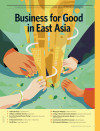"Philanthropy is the spiritual home for entrepreneurs,” entrepreneur Luming Ai said at the 18th annual conference of Yabuli China Entrepreneurs Forum, in 2018. Ai, who started his first business in 1988, is the chairman of Wuhan Dangdai Science & Technology Industries, the largest private company in China’s Hubei province, with more than $4 billion in assets as of 2017.
Business for Good in East Asia

This collection of articles, sponsored by the Leping Social Entrepreneur Foundation, delves into the cross-sector collaborations driving the latest social and environmental innovations throughout East Asia, including China, Japan, Korea, and Singapore.
-
Leading the Charge
-
Shifting to a Stakeholder Economy
-
Korea’s New Integrated Business Strategy
-
Seeking Common Ground
-
The SEE Way
-
Managing for Ambiguity
-
Creating a Vibrant Social Innovation Ecosystem
-
Southeast Asian Social Innovation Network
-
Social Investment Funds With a Conscience
-
Next-Generation Philanthropy
Launched in 2004, the Alashan Society of Entrepreneurs and Ecology (SEE) is the first nonprofit in China that was founded by a group of entrepreneurs to focus on ecological protection for the country. In November 2017, Ai was elected as SEE’s seventh president. He, along with 900 other business leaders, make up SEE’s founding members. Currently, SEE is the largest funder in the environmental protection area in China.
 (Illustration by Kimberly Salt)
(Illustration by Kimberly Salt)
An Entrepreneurial Awakening
In the westernmost part of Inner Mongolia Autonomous Region lies a seedbed of endless sandstorms threatening to Beijing. Alxa Desert is expanding at a rapid annual rate of 1,000 square kilometers, or about the size of a medium county town, and impacting southeast coastal areas as well as parts of Japan and Korea. In 2003, Liu Xiaoguang, then a general manager of Beijing Capital Group, visited Alxa Desert with other entrepreneurs. In the face of endless yellow sand, entrepreneurs at the meeting started to think about what they could do. Liu was the first one to put forward the notion to found SEE.
Liu believes that influential business leaders like him have a responsibility to do good for their country. Liu is joined in his environmental cause by high-profile business leaders, such as Wang Shi, founder of China Vanke, the largest real estate enterprise in China; Shi Yuzhu, founder of Giant Interactive Group, one of China’s most successful gaming companies; and Feng Lun, chairman of Vantone Investment Group, one of the oldest real estate companies in China. Wang and Feng became the second and fourth presidents of SEE, respectively.
In June 2004, nearly 100 entrepreneurs gathered at Alxa and declared the establishment of the SEE, a membership organization governed by entrepreneurs. Each member commits to donating 100,000 yen (about $14,000) every year. Following the principle of “one person, one vote,” all members will participate in the governance of SEE. Liu was elected the organization’s first president.
In 2008, SEE registered the SEE Foundation to make it easier to accept donations. Since then, tens of millions of yuan have been raised every year. In 2014, the SEE Foundation became a public foundation. SEE’s 2017 annual revenue was 201 million yuan ($29.19 million), while expenditures totaled 88 million yuan ($12.78 million).
Building Investment
China’s entry into the World Trade Organization provided rapid growth in the first decade of the 21st century, making it the second-largest economy in the world. Consequently, the number of entrepreneurs and their disposable wealth also increased alongside the nation’s economic growth.
SEE benefited from this prosperity. When Ren Zhiqiang, chairman of Huayuan Real Estate, was elected SEE’s fifth president in 2014, his goal was to recruit 200 members during his term. By the following year, membership was at 506, and membership has continued to increase each year; in 2018, there were more than 900 members.
Ai, who joined SEE in 2013, comes from a generation of entrepreneurs who received a socialist education and felt a duty to take on environmental and social responsibilities after China’s economic reform initiated in 1978. In order to continue the important work his generation has done for the environment, Ai is dedicated to the next generation of entrepreneurs. During his tenure as vice president of SEE, he recruited 61 members of the millennial generation, noting that their future welfare is in their hands: “Today many young people return after studying overseas, where they already have gained the awareness of environmental protection and philanthropy. Now they can join SEE to discuss with their peers how businesses can help protect the environment and advance philanthropy.”
While SEE’s membership has grown, the organization continues to insist on principles of equal participation, democratic decision making, checks and balances, transparency, and supervision both internally and publicly. This form of governance is unique in China. In recent decades, the practice of “concentrating power to accomplish big things” made great contributions to China’s economic growth. Quite a lot of entrepreneurs are accustomed to making quick decisions by concentrating power. In the nonprofit sector in China, organizations that strictly follow practices of democratic decision making in which all members participate are rare.
Ai became SEE’s first vice president in 2015. He made three promises in his campaign: to spend 50 percent of his time on SEE’s management and operation, to donate 12 million yuan ($1.73 million) in two years, and to recruit another 50 millennial members. He had already honored those promises when he ran for the presidency for the second time in 2017—a vote he won to become SEE’s seventh president.
Along with Ai, several young candidates were elected: five were born in the 1980s and two in the 1990s. All were of different ages, had diverse experiences, and came from different sizes of enterprises in a wide range of industries. They have distinct opinions and approaches and yet have made the same vow to fight for environmental protection. In fact, their divergence was greater than their consensus. SEE’s debating culture was unique among China’s nonprofits.
Cross-Sector Collaboration
SEE has three main focus areas: prevention and control of desertification, building green supply chains and pollution control, and ecological protection and nature education.
In order to tackle the first focus area, SEE works with local farmers and herdsmen to grow sacsaoul and tamarisk trees and use water-saving irrigation technology to delay the desertification process. In 2014, SEE launched the 100 Million Sacsaouls project to increase the existence of sacsaouls in key ecological zones in Alxa. SEE also introduced technology that grafted the expensive herb cistanche onto sacsaouls.
SEE taps into its advantage of being a club of entrepreneurs by cooperating with many big enterprises. It closely works with the Ant Financial Services Group under Alibaba via the virtual social media game Ant Forest. Users can grow a virtual tree by gathering enough green energy through walking, bicycling, paperless-online working, or the digital payment application Alipay and more. When the user plants one tree in Ant Forest, SEE plants one sacsaoul in the desert in reality. Users can literally see the growth of the tree by satellite image, which encourages more people to contribute to environmental protection.
Through this initial work, members of SEE realize that business, including their own companies, has a big impact on environmental protection. The organization’s second focus area revolves around building sustainable supply chains, and every SEE member is required to practice what he or she preaches in their own businesses. In 2016, the organization worked with the real estate industry to improve the environmental performance of suppliers of steel, cement, aluminum alloy, and timber. The initiative resulted in the white paper “Green Supply Chain in Real Estate Industry in China,” and a preliminary list of up-to-standard suppliers was created for real estate enterprises. The organization’s efforts also revolve around creating a set of environmental standards that industries are recommended to follow. For instance, SEE funds an NGO to evaluate the environmental data transparency indexes of many industries, and the pollution data of each enterprise is made public. This transparency has pressured more than 3,380 suppliers to change their systems to comply with environmental requirements; pollution data covers 364 cities.
Besides building awareness through its environmental projects, SEE is committed to the growth of environmental NGOs in China; most of them are still at a nascent stage with very few resources available. As of August 2018, SEE had funded 277 environmental NGOs with grants totaling 27 million yuan ($3.89 million). Located across China’s 31 provinces, cities, and autonomous regions, these NGOs are active in such areas as pollution prevention and control, ecology and environmental protection, and garbage reduction. In 2012, SEE launched the Hand-in-Hand project, which provides nonrestrictive funds totaling 300,000 yuan ($43,237) for three consecutive years to environmental NGOs. The project also helps build a team of advisors to support the growth and success of these NGOs. Between 2013 and 2018, the project funded 54 organizations with grants totaling more than 10 million yuan ($1.44 million).
From working with locals to educate them on water-saving systems to projects like Blue Soldier, which makes pollution data public, to projects like Free Fly, aimed at saving the most endangered waterfowl and its habitats, SEE is tackling environmental issues on all fronts.
SEE has grown as an important environmental organization in China. As a charismatic leader widely respected by entrepreneurs in the private sector, Ai sees his priority as SEE’s president is to “passing down SEE from generation to generation.” Led by Ai, SEE has reformed its organization structure to attract more forces to join. Local Project Centers are initiated by SEE members, and there were more than 23 centers by the end of 2018.
Under Ai’s leadership, SEE founded the Environment Philanthropy Institute in 2018. “We want to pass on our core values such as business for good to strengthen our capacity to grow even bigger. We may not find the best solutions to many issues, but it’s important to pass on some basic values and concepts,” he says.
SEE has received numerous awards from the government for its work. In the coming years, SEE will find ways to cooperate further with the government to leverage more resources. “Who is the largest-capacity provider in environmental protection in China?” Ai asks. “Not entrepreneurs. Not the public. But the government. The government is the biggest-capacity provider. We need to admit that and join hands.”
Support SSIR’s coverage of cross-sector solutions to global challenges.
Help us further the reach of innovative ideas. Donate today.
Read more stories by Yulin Li & Yong Wang.

